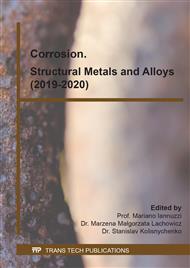p.69
p.74
p.81
p.89
p.95
p.102
p.109
p.119
p.125
Effect of Additives on Ash Corrosion on Heat Exchanging Surface of Biomass Boilers
Abstract:
This paper focuses on the problems of ash deposition and corrosion caused by alkali metal chloride in biomass boiler. Kaolin, pulverized coal ash, silica fume, dolomite, limestone and bauxite are used as additives in this study, to investigate the degree of corrosion of four metal materials on biomass boiler. The results show that the corrosion rate of metal samples is significantly reduced after adding additives. Kaolin, pulverized coal ash, silica fume and bauxite show much obvious effect on corrosion inhibition. Corrosion resistance of four pipe metals: T91>15CrMoG>12CrMoVG>20G, in which the corrosion resistance of T91 is much better than the other three metals.
Info:
Periodical:
Pages:
95-101
Citation:
Online since:
April 2020
Authors:
Keywords:
Price:
Сopyright:
© 2020 Trans Tech Publications Ltd. All Rights Reserved
Share:
Citation:




